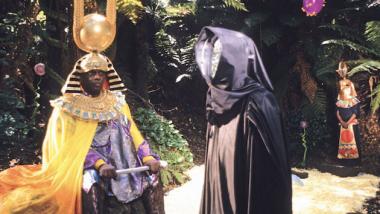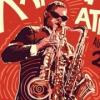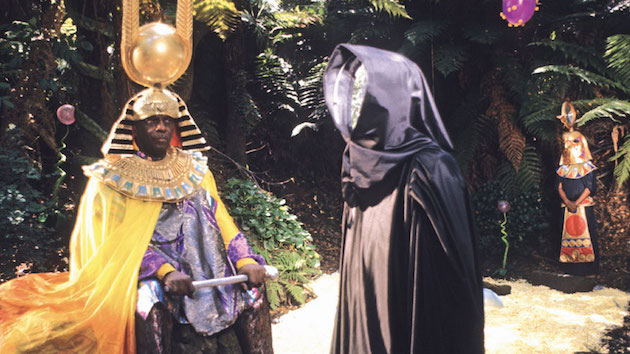
Jim Newman didn’t set out to make the most radical Afro-Futurist blaxploitation film of the 1970s. But then, everything about Space Is the Place, which started as a documentary project focusing on Sun Ra and His Intergalactic Solar Arkestra, was unlikely and paradoxical.
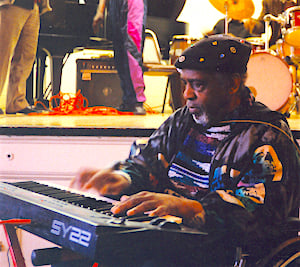
For decades, the 1974 film was more legend than fact. It never officially screened in theaters and was passed around like samizdat on VHS tape, in an abridged 64-minute version edited at the insistence of Sun Ra, the Zen-master-like pianist, keyboardist, composer, poet, visionary, and bandleader who blithely erased distinctions between avant-garde provocation and historically informed repertory.
A strict disciplinarian who strongly encouraged his bandmembers to shun women, booze, and drugs, Ra insisted that nudity and explicit violence be removed from the film, making him an odd choice indeed as the central figure for a blaxploitation flick (though not for the apocalyptic, sci-fi, black liberation tale that can also be found in the multifarious film). In 2003, Plexifilm released an expanded 82-minute version of the original Space Is the Place edit, and there have been several subsequent reissues, including an excellent Blu Ray production.
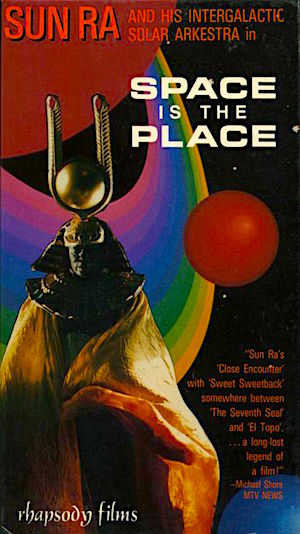
“Sun Ra never finally signed off on anything,” says Newman, 85, who produced the film. “There was a continuing discussion. He kept asking for outtakes to be sent to him in Philadelphia, where the Arkestra was based. For the shorter version distributed on VHS, we cut out some of the more violent scenes and implications of sexual activity. Finally, when it came out on DVD, we went back to the original edit, which is what is seen these days. It was never broadly distributed. It just sort of finds its way around.”
On Thursday and Friday, July 18–19, Space Is the Place finds its way to the SFJAZZ Center, where the film will be accompanied by the Sun Ra Arkestra under the direction of saxophonist Marshall Allen, 95, who joined the band during its formative years in Chicago in the late 1950s. Newman will be on hand for the July 18 screening. The Arkestra also performs on its own July 20–21.
The story of how the film got made illustrates the protean nature of America five decades ago, as John Szwed noted in his probing and sympathetic biography Space Is the Place: The Lives and Times of Sun Ra (Pantheon): “by means which were only conceivable in the late 1960s and early 1970s, Sun Ra was appointed a lecturer at the University of California, Berkeley through the Regents Program and the Department of Afro-American Studies,” teaching a course titled “The Black Man in the Cosmos” that detailed his deeply informed and supremely idiosyncratic philosophies. The reading list included The Egyptian Book of the Dead, Henry Dumas’s Ark of Bones, P.D. Ouspensky’s A New Model of the Universe, Theodore P. Ford’s God Wills the Negro and at least a dozen other books, pamphlets, and periodicals.
Born Herman Poole Blount on May 22, 1914, in Birmingham, Alabama, Sun Ra was recognized as an exceptional musical talent in his hometown. He employed many different names before settling on Sun Ra (and departed Earth on May 30, 1993). Like tenor-sax giant Lester Young, Ra was traumatized by his service in the segregated Army during World War II, and by 1946 he’d relocated to Chicago, where he spent years writing and arranging music and rehearsing stage shows at the Club DeLisa for bandleader Fletcher Henderson, who’d pioneered big-band jazz in the 1920s.
By the mid-1950s, Ra had attracted a devoted cadre of musicians who lived communally and spent countless hours rehearsing his music, which increasingly made use of extended techniques, dense, lapidary textures, and early versions of electric keyboards. The Arkestra often chanted Ra’s poetry about space travel. Treating rehearsals as consciousness raising sessions, he’d lecture about his philosophy of life and music for hours at a time, while also given to koan-like word play. “It ain’t necessarily so that it ain’t necessarily so,” he said.
Marshall Allen had been exploring the outer reaches of the alto saxophone’s possibilities when he joined the band and had to rethink his entire approach to the art form. “I’m thinking, thinking I play what I know, and he’s talking about, playing what you don’t know,” Allen says. “Sun Ra was writing music in different internals and time signatures and time zones, and putting it all together like a puzzle. That was something different. All this counterpoint was new for me then. I couldn’t understand what he was doing, and what he wanted me to do.”
The Arkestra started to make inroads in the Bay Area in 1968, performing around the region. Jim Newman, a saxophonist and seminal figure on the West Coast art and music scene since the 1950s, got word that the singular ensemble was going to perform at the San Francisco Art Institute. “I knew the name but didn’t know what the music was,” recalls Newman, who played baritone saxophone in the Junius Courtney big band for some three decades. “I was absolutely blown away with what was going on there. I’ll never forget that.”
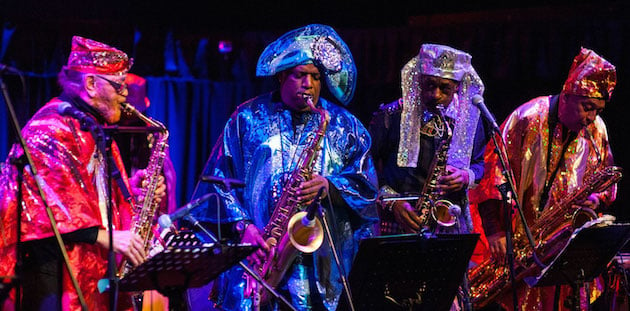
He’d been involved with KQED, which had become one of the most adventurous stations in the public-television constellation, sponsoring a film series commissioning works on artists produced by John Coney. San Francisco Chronicle critic Ralph Gleason had already earned national acclaim for his documentaries on Duke Ellington, Love You Madly and A Concert of Sacred Music at Grace Cathedral.
“I asked John to consider doing something on Sun Ra and he was very interested,” Newman says. “We thought we’d do a performance documentary piece and arranged to have the band assembled at Planetarium. That never came to pass.”
Filmed throughout 1972, the documentary morphed into something very different. Eventually Newman and Coney brought in Joshua Smith to develop a script, and the film evolved into a tale of Sun Ra engaged in a cosmic card game with the pimp-like Overseer with the fate of black people in the balance. Ra wants to relocate black folks to his planet, and starts recruiting people via his Outer Space Employment Agency. Ra ends up winning the contest and the Arkestra’s space ship sails off into the cosmos, leaving Earth behind to its fate. Ra had so much input into the script that he ended up with a co-writing credit. Allen remembers the time as a fruitful one for the band.
“We were playing at universities all over,” he says. “It was good. We’re going to be in a movie, that was nice! We had the space ship that was out on the campus and we shot all around Oakland. I was doing a lot of prop stuff. I wasn’t featured. I had fun and it was wonderful.”

